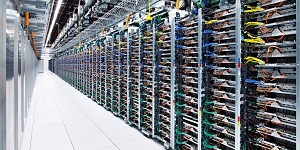Question: Who do you know that doesn’t have data access on their phone? Answer, almost nobody. Most users have always-on data updating social media, emails, video and news feeds. But although users think these services are free, they are not. And the cost to unsustainable resources is getting scarily bigger. By Jeremy Torr.
Singapore, 1 March 2018. ”It is estimated that in 2016, data centres worldwide gobbled up 416 terawatts of power per hour. That’s one and a half times the electricity consumption of the United Kingdom,” says sustainability journalist Marco Magrini. “And it is predicted that this [consumption] will double every four years.”
Always on means always being connected to data centres. And data centres use increasingly large quantities of power. Courtesy Asus Computer.
It has been estimated that current data centre power consumption contributes as much if not more atmospheric carbon dioxide (through power generation processes that use coal, oil, and gas) as the entire aviation industry including over 23,000 aircraft pouring burnt aviation fuel into the skies every day.
Take Microsoft. Although not a major social media player, it offers cloud computing and network services to millions of users worldwide. In planning ahead for the massive data traffic this will generate, it spent some US$0.75 billion in 2015 on a spanking new data processing centre in Wyoming.
At the launch, officials pointed out that the site was ideal, because the naturally cool climate decreases cooling costs (thousands of always-on servers generate huge amounts of heat). Global warming; tick. Even more worrying was the issue that could have clinched the deal: Wyoming has some of the lowest electricity prices in the US – thanks mainly to coal. “We have abundant, affordable energy,” said Wyoming ‘s representative at the opening, Matt Mead. CO2 emissions; tick.
Report Card
Although not widely recognised as a problem, some organisations are waking up to the potential threat both from greenhouse gas emission/power consumption perspective, and from the challenge of getting rid of the vast amounts of generated heat – one recent Facebook data centre sits on a 20-plus acre site, completely occupied by server buildings with tens of thousands of computers inside.
Some data centres have tens of thousands of computer servers running 24 hours a day. Photo courtesy Apple.
“The energy footprint of the IT sector is already estimated to consume 7% of global electricity,” says Greenpeace in a recent report on the issue. It goes on to note that if data corporations actively pursued renewable energy policies, the internet and data centres could realistically act as a vangaurd of a renewably powered economy.
“But if our growing digital infrastructure is built in the opposite direction, [it would] lock us into a dramatic increase in the demand for electricity from coal and other dirty sources of energy that are changing our planet’s climate,” it warns.
It’s not all dismal though. Many internet companies are more active than other industries at seeking to use renewables. Greenpeace notes that renewable energy bought by US corporations in has increased dramatically since 2010, exceeding 3.2GW in 2015 alone; better still, more than 65% of this has been from electricity deals with major internet companies.
Lots of data centers consume extra energy just to disperse generated heat. Courtesy Facebook.
Some companies are being smarter about where they site their data centres. Facebook opened a new centre in Finland, near the Arctic Circle, where cooling is less of a power consumption issue, and where it can tap into renewable hydropower supplies. Admittedly it will still consume as much power as about 100,000 homes – but at least the company is trying to mitigate the sustainability challenges.
But worryingly, the main culprits behind the explosive and power hungry expansion of digital power needs are possibly the areas creating greatest excitement in digital business. They are video streaming, artificial intelligence, and digital blockchain currencies. The first, video streaming, has been driven principally by the use of the internet to supply movies.
Scary Movies
"Data centres use up one and a half times the electricity consumption of the UK" - Marco Magrini.
Greenpeace reports that streaming is a tremendous driver of data demand, with 63% of global internet traffic in 2015, projected to reach 80% by 2020. Netflix alone already accounts for over one-third of internet traffic in North America. That demands a lot of data centre capacity on its own. Then there is the next big thing – home speaker and integration systems driven by artificial intelligence.
And guess where the intelligence is? Not in your phone or computer, but on the server which is demanding extra power to run all those sophisticated algorithms so you can ask a smart box to turn down the fridge to the optimum temperature.
Video supplier ranking in terms of energy usage. Courtesy Greenpeace.
And lastly, digital currencies (although no doubt an effective alternative to current cumbersome and manual-based transaction standards) consume huge amounts of power during the data mining process to create the individual bitcoin entities.
According to the Digiconomist website, Bitcoin mining and transfer tracking uses power at an annual rate of 32TWh, or somewhere round that of a small-sized Euro economy. By the site's calculations, each Bitcoin transaction consumes 250kWh. And some commentators claim that if the current blockchain boom continues, the processing power required to drive it will almost double the world’s energy requirements within the next few years.
Magrini already estimates that Bitcoin’s energy consumption equals around the same as 3 million typical US households, and although big names like Google and Apple, who pay diligent corporate responsibility executives, are making many of the right noises about using renewables for their power needs, the current situation is, he says, unsustainable.
“While the world keeps running on fossil fuels, our digital sustainability is in question,” he says.




